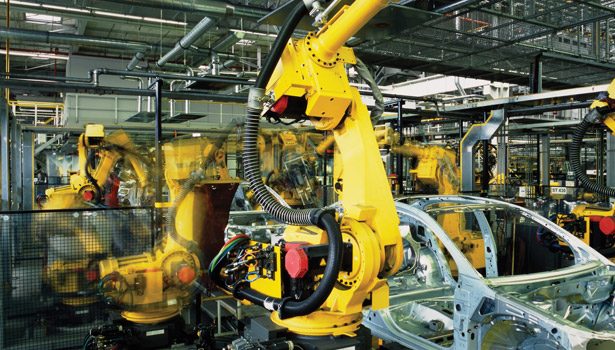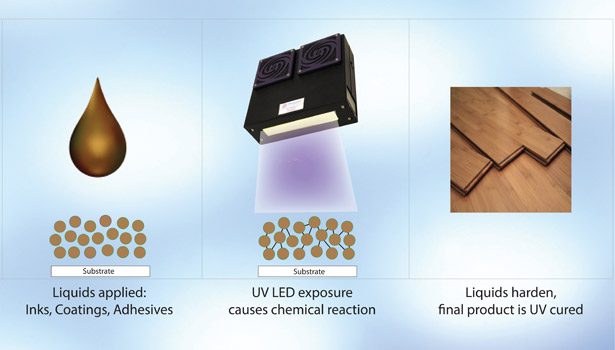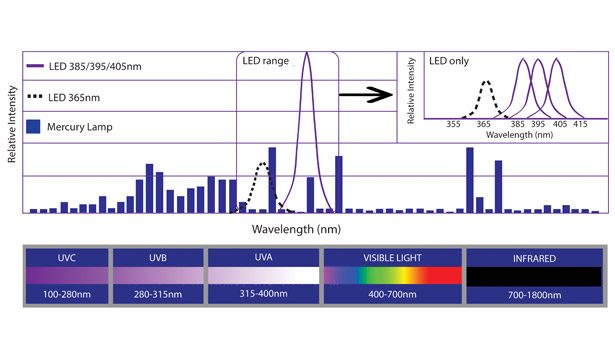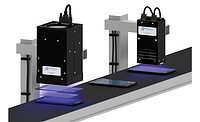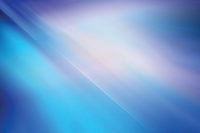UV LED curing refers to a technique that uses “energy” output from the light emitting diodes (LEDs) in the ultraviolet (UV) spectrum to treat coatings, adhesives, inks and other UV-curable materials. The energy generated by the UV light triggers a chain reaction, resulting in polymerization of the wet raw material, thus hardening (or curing) the material (see Figure 1).
UV LED curing technology uses semiconductor-based LEDs to project UV light when an electric current is passed through them. When an LED is forward-biased, electrons are able to recombine with electron holes within the device, thus releasing energy in the form of photons. The color of the light emitted, or the corresponding energy of the photon, is determined by the energy gap of the semiconductor material.
The benefits of UV LED curing are numerous and significant. UV LEDs are a cool source compared to traditional lamps, largely due to no output in the infrared range. This reduced heat eliminates complicated cooling mechanisms such as chill rolls and external shutters, and enables applications on heat-sensitive substrates. The electrical-to-optical conversion efficiency of UV LEDs is much better, saving about 50-75% on electricity. In addition, UV LEDs are more environmentally friendly because they do not generate ozone and contain no mercury.
Technology Building Blocks
UV LED curing lamps consist of multiple subcomponents that, when optimally combined, can drive the system performance. Key components of the UV LED light source can be grouped into four categories: LEDs, arrays, optics and thermal.
LEDs
LEDs consist of semiconducting material that is doped with impurities to create a p-n junction. Charge carriers, both electrons and holes, flow into the junction from electrodes (anode and cathode) with different voltages. When an electron meets a hole, it falls into a lower energy state, resulting in the release of energy in the form of a photon.
The wavelength of the light emitted depends on the band gap energy of the materials (dopants) forming the p-n junction. The right combination of LEDs maximizes the total UV energy.
Arrays
Arrays are a grouping or clustering of individual LEDs. The number, type, and size of LEDs, including the shape of the array and the method of electrically connecting the LEDs, impact the array. The array architecture is targeted for both air- and/or water-cooled applications. The target application ensures the optimal performance and reliability for the system manufacturer.
Optics
Photons coming out of the light source are optimized through the use of various optical layouts. Optics are used in reflecting, molding, guiding and shaping the UV LED light to maximize the energy reaching the media to optimally cure the UV material. The use of optics has three benefits to the user:
• Increases the efficiency of the UV energy irradiated onto the material
• Lowers the heat generated by an array
• Provides for optimal system pricing
Thermal
UV LEDs can last up to 20,000 hours and beyond if they are maintained at a proper operating temperature. As LEDs emit more energy, they also generate more heat, which needs to be managed. Thermal management techniques remove excess heat from the system while providing a consistent operating temperature for the diodes to function at maximum performance, providing longevity to the lamps.
Wavelength
UV LED lights have a narrow spectral output centered on a specific wavelength of ± 5.0 nm. LEDs are a solid-state device; they can be built with various wavelength diodes including, but not limited to, 365, 385, 395, 405, and 410 nm (see Figure 2). This differs from the broad spectrum of wavelength ranges that are output by traditional UV lamps. This monochromatic distribution requires new chemical formulations to ensure proper curing of UV materials.
Commercial Applications
Some of the earliest UV LED commercial applications were small-area adhesive and bonding applications such as medical device assembly; low-end thermal inkjet printing applications such as marking, coding, and variable printing; and field repair of fiberglass composites. These early applications took advantage of the UV LEDs’ form factor (lightweight and small), throughcure capabilities, and the increased safety inherent with longer wavelengths. In fact, many of the earliest applications were actually in the visible wavelength range.
Today, UV LED curing is gaining traction in the manufacturing world for a variety of coating and adhesive applications. UV LED curing technology is a good fit for many assembly applications, providing higher throughputs, controlled process repeatability, and operator safety. The manufacturing industry is driving toward various new challenging applications to use UV LED curing lamps.
Coatings
A significant number of coatings worldwide are cured today with UV LED sources in applications ranging from traditional materials such as flooring and cabinetry to advanced electronics. Material development and long-term performance testing will further open markets in the areas of automotive, electronics, residential, and commercial construction materials.
UV LED curing technology is ideally suited for the wood coatings industry for applications such as edge coating, roller coating and digital printing. UV LED technology drastically reduces energy consumption and significantly reduces workpiece surface temperature. Another emerging application is display manufacturing for cell phones, OLED?TVs and touchscreens. UV LED technology is a great fit, offering more consistency and less heat.
Adhesives
UV adhesives are a beneficial tool in modern assembly and manufacturing processes, with UV LED electronic control and stability ensuring excellent results in a variety of UV LED adhesive applications, ranging from medical devices to the most advanced consumer electronics.
UV LED curing of adhesives has shown benefits in medical and pharmaceutical applications because of their small form factor, ease of setup, and minimized heat generation. Since the parts are very small, the challenge lies in using the UV LED light to cure adhesive in a small area to mechanically bond the components together.
Mass-produced consumer electronics applications benefit from the long life, reliability and repeatability of UV LED curing systems. The ability to function at optimum levels, even during long-lasting, high-volume jobs—and provide consistent output when curing very sensitive products—makes UV LED technology an effective solution in these markets.
Increasing Acceptance
UV LED curing is fast becoming an accepted, user-friendly technology in a variety of manufacturing processes, as it provides significant benefits for a variety of industrial processes. The change from conventional curing technologies to UV LED provides manufacturers with lower operating costs and higher quality products while enabling new capabilities.
The regulatory environment also is moving forward. Mercury bulbs are currently exempted from the European Union’s RoHS (Restriction of Hazardous Substances) Guideline. That exemption is slated for review in July 2016 for both large- and small-scale uses. Much like LED bulbs are replacing incandescent bulbs due to energy efficiency and no hazardous materials, it is possible similar restrictions will be extended toward mercury bulbs with the rapid growth of UV LED lamps.
For additional information, visit www.phoseon.com.
